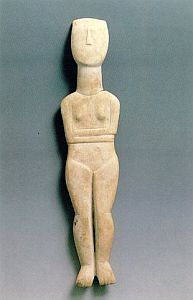
From CBSNews (excerpt):
"What is particularly impressive is not just the bulk of the finds, which is larger than the total from the rest of the Cyclades, but also that they were intentionally broken during ancient times," Sotirakopoulou said. "Therefore, this is a very important, a unique site."
The Cycladic culture _ a network of small, sometimes fortified farming and fishing settlements that traded with mainland Greece, Crete and Asia Minor _ is best known for its elegant artwork: mostly naked, elongated figures with their arms folded under their chest. The seafaring civilization was eclipsed in the second millennium B.C. by Crete and Mycenaean Greece.
...
Evidence from excavations in the '60s and 1980s failed to explain why the barren islet was so much more important in the 3rd millennium B.C. than its bigger, more hospitable neighbors.
"The prevailing explanation is that this was a sacred repository, a sort of pan-Cycladic sanctuary where people left objects within the framework of rituals which included their intentional smashing," said Sotirakopoulou.
She will participate in the summer's excavation together with Cambridge University professor Colin Renfrew and other experts.

No comments:
Post a Comment